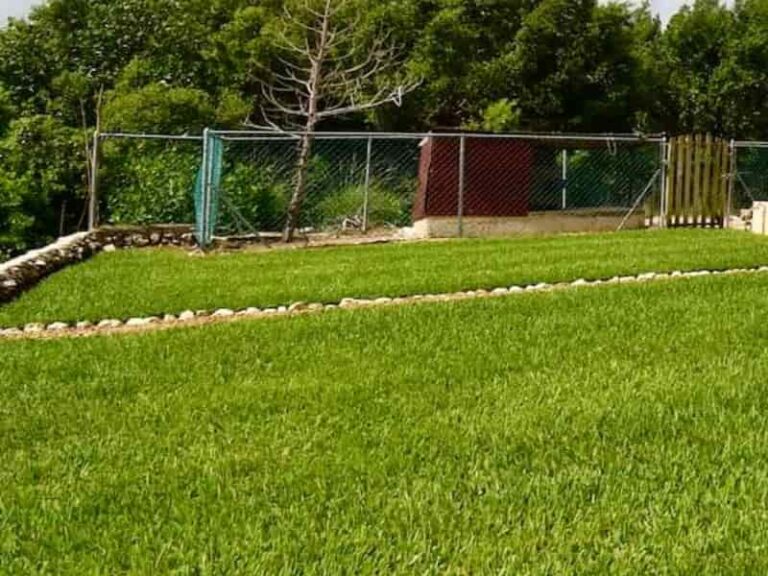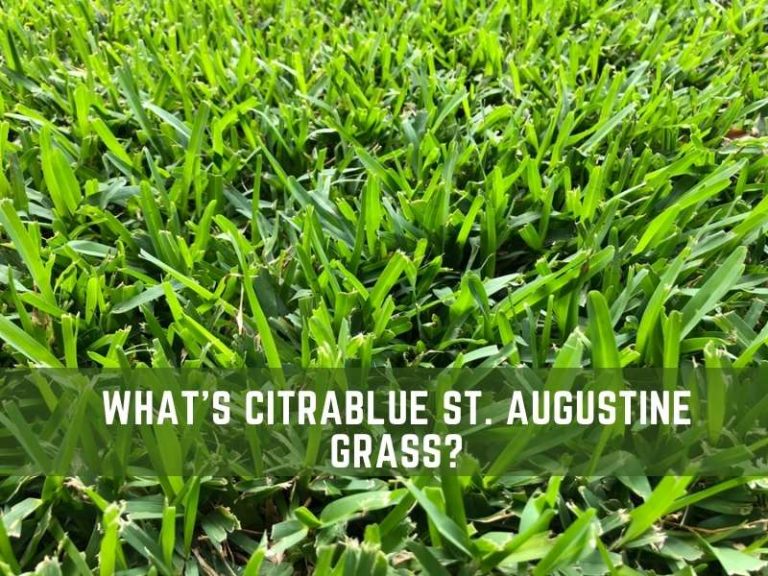Zoysia Vs. St Augustine: Differences & Which Is Best To Choose?
Zoysia grass and St. Augustine are two common options that usually come up in the quest for a warm-season turfgrass for your lawn. They share some similarities, but they have differences too. These differences help in deciding why you should choose one over the other.
Zoysia grass and St. Augustine differ in the matter of texture and hardiness. Zoysia’s soft feel and velvet texture feel great beneath your feet, while St. Augustine holds up solidly to drought. However, if you choose Zoysia for your lawn over St. Augustine, keep your lawn mower well-oiled.
Both grass types exhibit unique growth patterns and needs. I have researched the best ways to identify and differentiate Zoysia grass vs. St. Augustine grass.
Here are some differences between these turfgrasses that can help you decide the best grass for your lawn.
What is Zoysia Grass?
Zoysia is a genus of warm-season grasses renowned for their excellent drought tolerance and durability, even in high-traffic turfs. It resembles Bermuda grass in appearance but has stiffer leaf blades. Zoysia is a perennial that re-establishes itself under the right environmental conditions on turfs every season without replanting.
Zoysia grass has rolled vernation; the youngest grass blades are rolled inside the leaf sheath. It also has hairy ligules at the point where the leaf blade meets the leaf sheath, a common feature amongst warm-season grasses. Zoysia doesn’t have auricles extending from the collar.
Zoysia grass has a low growth profile and is both stoloniferous and rhizomatous. It forms an even, thick, fine-textured turf with a beautiful medium-green shade. However, Zoysia grass loses its color as it enters winter dormancy.
The leaf blade feels stiff to the touch and has a pointed tip. If left to grow without mowing, Zoysia grass produces a spike-type seed head, with seeds alternating on either side of the spikelet.
What does Zoysia look like?
Zoysia grass has fine/coarse-textured leaves that appear rolled in the bud shoot. The leaf color ranges from light to medium green (depending on the species) with a dense and compact growth pattern. The leaves are stiff due to the high silica content, and the presence of rhizomes and stolons make for a significant distinguishing feature of the Zoysia grass (which can reach 6 to 12 inches in height).
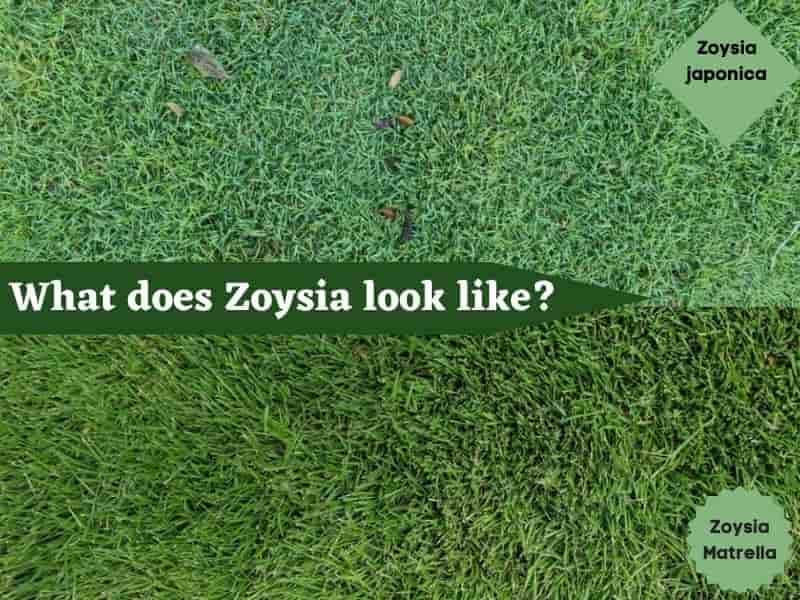
Zoysia lawns are established from three principal species;
- Zoysia japonica (Korean or Japanese lawngrass)- most cold-resistant, established from seed or sods (improved), and faster spreading variety.
- Zoysia matrella-moderate shade tolerant, forms a thick mat in full sun, propagated from sprigs, and is quite slow to establish.
- Zoysia tenuifolia– is the finest textured, least winter hardy but forms quite a dense-fluffy turf.
Recently, newer Zoysia cultivars like Emerald Zoysia, El Toro Zoysia, and Victoria Zoysia have gained popularity amongst turf experts for their improved establishment rate.
What is St Augustine Grass?
St. Augustine grass(Stenotaphrum secundatum) is a warm-season, perennial turfgrass species beloved for its excellent heat tolerance. This grass species thrives in different soils and grows in saline soil conditions.
St. Augustine grass blades are dark-green and smooth, with hairs around the collar region. The coarse-textured leaf blade is keeled/boat-shaped and has a rounded tip. A prominent, white midvein runs along the length of the leaf blade.
St. Augustine grass also has membranous, short-haired ligules at the intersection of the leaf sheath and blade. It, however, lacks auricles. Meanwhile, the leaf sheaths are distinctly compressed against each other and are difficult to pull apart.
If not mowed, St. Augustine grass produces seed heads of racemes containing 1-3 spikelets each. The flat purple-colored racemes are usually 3-5 inches long.
St. Augustine grass has a creeping growth pattern and spreads via stolons, which are above-ground offshoots that run lateral to the soil surface and develop new shoots and roots at intervals. This grass species grows relatively fast and can creep into neighboring flower beds if not controlled.
What does St. Augustine grass look like?
St. Augustine grass has broad, flat, dark green leaves that appear densely coarse when touched. The grass forms a compact surface making it ideal for use as turfgrass. On maturity, the grass can reach a height of about 12 inches (with some species exhibiting flower and seed development).
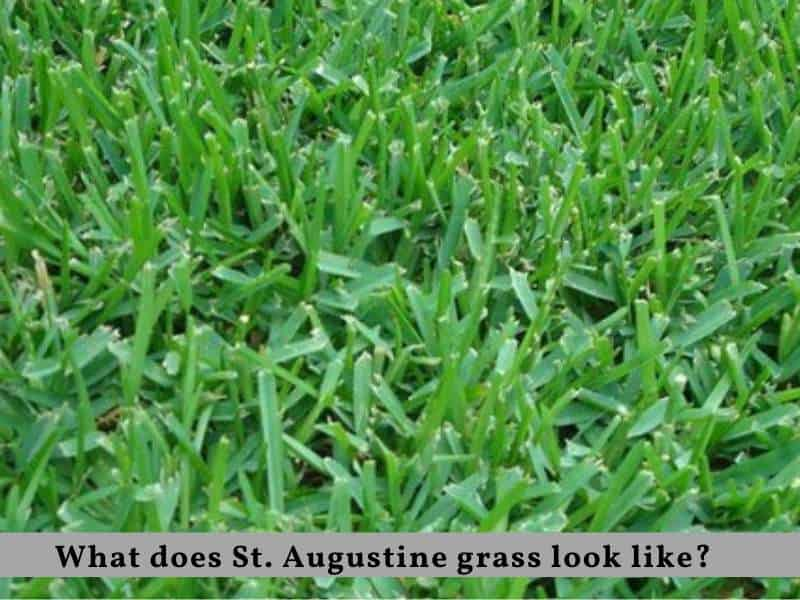
The common types of St. Augustine grass cultivators;
- Palmetto St. Augustine – semi-dwarf, has a plush appearance, fewer thatches, medium-width blades, and stays green the longest.
- ProVista St. Augustine – darker green color, better shade tolerance.
- Raleigh St. Augustine – medium green color, coarse texture, yellows, and grow less aggressively in summer.
- Seville St. Augustine – dwarf version, retains blue-green well year-round and shade and drought resistant variety.
- CitraBlue St. Augustine – has unique deep blue-green color, more drought tolerant, disease and weed resistant to form plush turf.
- Floratam St. Augustine – long and thick blades, highly resistant to drought to retain color even in extreme weather conditions.
- Other- Roselawn and Floratine St. Augustine.
Zoysia vs. St Augustine – key differences
Here is a summary table for differences between St. Augustine grass vs. Zoysia grass:
| St. Augustine grass | Zoysia grass |
| Dark-green, coarse-textured leaf blade with rounded, keeled apex. | Medium-green, fine-textured leaf blade with sharp-pointed apex |
| Thrives in saline soil, but not compact or slow-draining soil | Thrives in compact or slow-draining soil but struggles in saline soils |
| Tolerate shade well | Less shade tolerant than St. Augustine |
| Spreads via stolons only | Spreads via both stolons and rhizomes |
| You can establish it via sods, sprigs and plugs | You can grow it from seed, sod, sprigs, and plugs |
| Slow to recover from physical damage | Recovers faster from physical wear |
| Cheaper sods-relatively cheap to establish and maintain-needs in terms of mowing, watering, and fertilizing. | Costly sods, expensive to establish, and costly to maintain-needs closer monitoring to prevent frequent diseases |
| Mow 2 to 4 inches every 10-14 days | Mow 1 to 3 inches every 7-10 days |
| Prone to grubworms, armyworms, chinch bugs, spittlebugs, grubs, ground pearls, and mole crickets | Prone to billbugs, chinch bugs, mole crickets, grubs, and ground pearls |
| Tolerates a wider soil pH (range of 5.0 to 8.5) | Tolerates a narrower soil pH (range of 5.5 to 7.0) |
| Better at choking out weeds as it grows faster | Slow to fill in, bit crowds out weeds once it does |
| Best for USDA zone of 8 to 11 | Best for USDA zone of 5 to 11 |
Zoysia grass and St. Augustine grass share many characteristics, such as excellent heat tolerance, hairs at the base of the leaf blade, and the absence of auricles. However, there are several differences between these two warm-season turfgrasses. You can compare Zoysia and St. Augustine by their physical features, growth habits, environmental preferences, and maintenance requirements.
Physical features
The Zoysia leaf blade has a sharp tip, while St. Augustine grass has a rounded, keeled apex. The Zoysia leaf blade also has a medium-fine texture compared to the coarse-textured St. Augustine leaf blade.
Growth habit
Both Zoysia grass and St. Augustine grass have a creeping growth habit. However, while the former spreads via above-ground stolons and underground rhizomes, St. Augustine is only stoloniferous.
Zoysia grows at its peak in late spring and summer. The plant prefers warm climatic conditions and slowly spreads out laterally over time. The grass spreads through above and underground stems (stolons and rhizomes) to create a dense green carpet ideal for lawns, golf courses, etc. The underground rhizomes remain intact if the Zoysia lawn is scalped, mowed too low, or aggressively dethatched.
St. Augustine a fast-spreading turfgrass variety that grows well in warm weather. The growth is mainly propagated by stolons, making the species ideal for owners looking to quickly fill bare spots on their lawns or other outdoor spaces. Meanwhile, the stolons of St. Augustine suffer considerable damage due to low mowing and invasive dethatching. Due to this difference, Zoysia grass recovers faster from physical injury than St. Augustine in such situations.
Propagation/ establishment
You can grow a Zoysia lawn from seed, the most affordable way to establish a lawn. Yet, you can’t establish a St. Augustine lawn from seed. Grass seed suppliers don’t stock it due to the limited amount of the grass’s viable seed. To establish a St. Augustine, you must go for costlier vegetative propagation options, sodding, plugging, and sprigging.
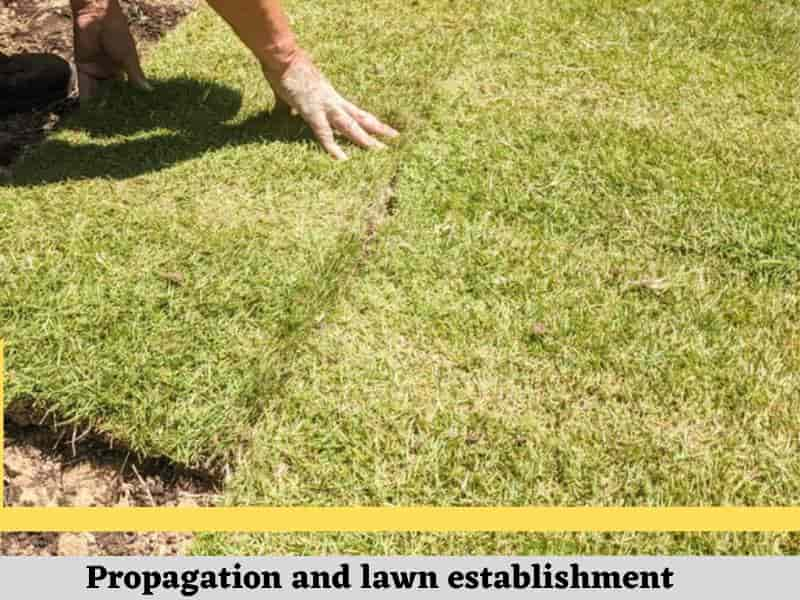
Drought tolerance
Zoysia and St. Augustine have exceptional heat tolerance, but their tolerance to dry soil conditions differs. St. Augustine grass has moderate drought tolerance and will only withstand high summer heat if it receives enough moisture. Comparatively, Zoysia grass has a denser root system and stays green during prolonged heat and drought periods in the summer.
Note: During a drought, Zoysia grass will go dormant and turn brown within a week, which may make it seem less drought-resilient than St. Augustine. However, when St. Augustine grass finally turns brown in a drought, it means it’s dying and won’t recover even when watered. On the other hand, Zoysia quickly comes out of dormancy and greens up the first time you irrigate it after a drought.
Shade tolerance
St. Augustine grass boasts better shade tolerance than Zoysia grass. The latter turfgrass will likely struggle in shaded lawns and needs more sunlight exposure, while St. Augustine can thrive in less sunlight.
Salt tolerance
St. Augustine grass has high salt tolerance and will still grow in the saline soils found in coastal regions. By contrast, Zoysia is only moderately tolerant of saline soil conditions and is likely to die due to salinity stress in excessively salty soils.
Weed resistance
Both St. Augustine and Zoysia grasses form dense turf that easily crowds out weeds. However, St. Augustine forms denser turf while Zoysia grass grows slowly and takes a long time to fill in (6-8 weeks), giving fast-growing weeds a head start. On the contrary, St. Augustine grass establishes a bit faster and can effectively choke out most types of weeds.
Maintenance requirements
Though both types of grass are relatively low-maintenance, Zoysia requires more care and maintenance than St. Augustine. For starters, Zoysia is more prone to diseases. However, it is a low-growing grass and thus doesn’t need to be mowed often. Comparatively, St. Augustine grass grows significantly taller and requires frequent mowing at 2-4” height for deeper root growth.
Zoysia and St. Augustine grass varieties are excellent turfgrass options for outdoor space. Both cost about $0.30 to $0.80 per square Ft. to purchase quality sods (though prices vary depending on location, delivery, and additional labor costs). However, each species has a unique maintenance schedule that distinguishes one from the other.
Zoysia grass: requires constant attention and maintenance to retain its attractive features. The upkeep translates to a time and monetary investment for those looking for an easy-to-maintain turfgrass option for their private/commercial properties.
St. Augustine grass: has a relatively lower maintenance cost than the Zoysia grass variety. However, the grass requires frequent fertilizer applications, and watering requires relatively high maintenance compared to other turfgrass species. St Augustine is highly aggressive, meaning you must invest considerable time mowing the lawn surface during its active growth period.
Read Also: St. Augustine Grass Diseases and Problems
Water/fertilizer requirements
Zoysia and St. Augustine grass varieties have specific water and fertilizer requirements that can be useful when distinguishing one type from the other.
Zoysia grass water and fertilizer requirements include:
- Water requirements: The grass requires only about 1 inch of water per week, ideally during the morning hours. Zoysia can tolerate short periods of droughts.
- Fertilizer requirements: During active growth periods(May to August), for Zoysia’s best fertilizer application, apply about 1 pound of nitrogen per 1,000 square feet every month. If soil pH is below 6.0, add lime to increase pH. If the soil tests show your soil is deficient in nitrogen(N), phosphorus(P), and potassium(K), add lawn fertilizer with a ratio of N:P: K of 3:1:1 or 4:1:1 or 4:1:2.
St. Augustine grass water and fertilizer requirements include:
- Water requirement: To remain healthy, it requires about ¾ inches of water per week. It’s best to water the grass twice a week during the warmer months.
- Fertilizer requirements: Apply 1 pound of soluble nitrogen per 1,000 square feet of lawn every two months after the grass turns green (after dormancy) to promote foliage and ensure the grass remains green.
Soil preferences
St. Augustine grass can grow in 5.0-8.5 pH soil and survive in highly acidic and alkaline soil types. However, Zoysia can only withstand 5.8-7.0 pH. St. Augustine grass is, therefore, the more versatile turfgrass of the two by this standard.
Zoysia beats St. Augustine’s intolerance of grass for poor-draining soil like clay and low-nutrient soil. Zoysia grows well in slow-draining, clay soils, while St. Augustine grass struggles in such conditions. Zoysia is the best grass variety for sandy soils since it has lower fertilizer requirements than St. Augustine and will still thrive in nutrient-deficient soil where St. Augustine fails to grow.
See Also: Best grass for clay soil
Mowing needs
Zoysia and St. Augustine grass varieties require regular mowing to maintain a sustainable height and keep your space clean and tidy.
Zoysia grass: Spreads more slowly compared to other varieties; hence you can cater to its mowing need by:
1. Mowing once it reaches 1 ½ to 3 inches in height.
2. Maintaining at least ⅓ of the average blade height (you can mow to heights less than an inch using specialized equipment).
3. Mowing to about 2-2.5 inches if it grows under partial shade.
4. Mowing after its winter dormancy, preferably from late April to early May.
5. Mowing every 7 to 10-day to make grass thicker and give it a compact appearance.
St Augustine grass: Spreads faster than Zoysia; hence you should cater to its mowing needs by:
1. Maintaining mowing height from 2 ½ to 3 inches.
2. Mowing to about 3½ to 4 inches in shady areas.
3. Mowing in early spring after the grass color changes to green.
4. Retaining at least ⅓ of the original leaf foliage height to keep lawn aesthetics and safeguard against scalping your lawn.
5. Mowing every 10 to 14-day.
But, when is the best time to mow new sods? The best best time of day to mow established lawn is between 8:00 am and 10:00 am since grass will be dry and free of morning dew.
Ideal growing zones
Zoysia and St. Augustine grass varieties thrive in diverse environments and growing locations. The best growing locations vary from one species to another.
Zoysia grass: A highly adaptable species that can grow in the following conditions:
- Zoysia grass grows best in USDA zones 5 to 11. The warm weather grass can tolerate cold and also withstand heat and dry weather.
- Zoysia grows best when exposed to 6 to 8 hours of full sun and a soil pH of 6-6.5.
- Zoysia also thrives when temperatures are (80 to 95°F) during spring, summer, and early fall(60 days before the first frost).
St. Augustine grass: Prefers the following conditions:
- St Augustine likes warm climatic regions that range from 8 to 11 on the USDA chart. It is the least cold tolerant of all the warm-season grasses.
- St. Augustine grows best during warmer seasons(spring & summer when temperatures range from 80°F to 100°F).
- St Augustine likes full 90 days of sun before the first fall frost and soil pH of 6-6.5. The 90 days before the first fall frost gives your St. Augustine enough time to grow before the cold weather sets in.
Grass height
You can distinguish Zoysia from St. Augustine grass by considering the different height averages of individual grass species.
Zoysia grass: Reach a height of about 6-12 inches if left to grow undisturbed. Some Zoysia grass species grow in dense clumps, which might become more pronounced if the grass grows without regular maintenance.
St. Augustine grass: Reach a height of up 12 inches if left to grow unchecked. The grass also develops small white-red-like flowers and might produce seeds on maturity. St. Augustine grass grows aggressively during its active growth phase (and might demand constant attention compared to other turfgrass species).
Diseases and pests tolerance
Zoysia and St. Augustine grass varieties have different tolerance levels to pests and diseases. You can readily distinguish the species by considering their ability to resist diseases and infestations.
Zoysia grass: Tolerant to chinch bugs that attack other types of turfgrass. However, the grass is susceptible to pests like armyworms, billbugs, mole crickets, etc., and fungal attacks.
Zoysia grass appears bleached with dry patches when affected by diseases like:
- Root rot.
- Large patch fungus.
- Parasitic nematodes.
St. Augustine grass: A hardy species that can withstand numerous conditions. However, the grass is highly susceptible to attacks from different pests like chinch bugs, grub worms, sod webworms, armyworms, etc.
St. Augustine grass will change from green to yellow/brown and have conspicuous dry patches that peel from the soil when affected by:
- Root rot.
- Brown patch fungi attacks.
- Stolon rot from the Niglospora fungi.
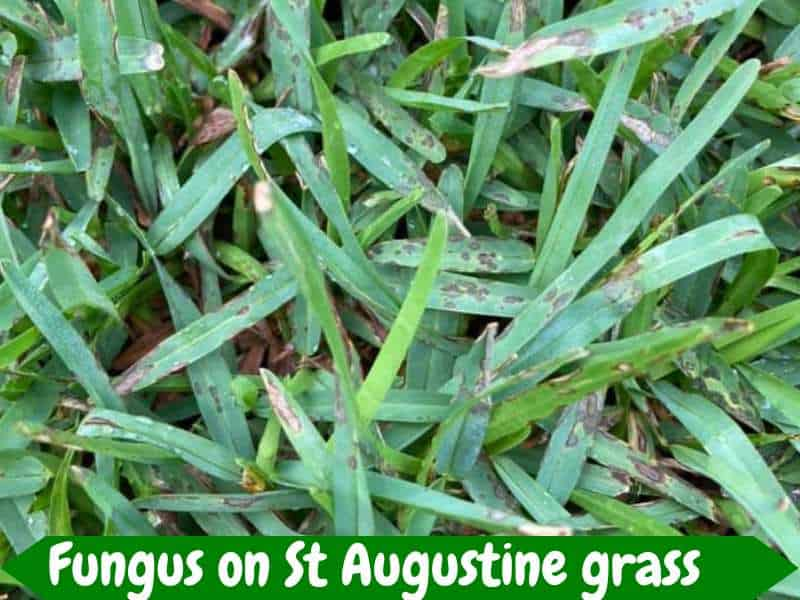
Note: Symptoms vary depending on the pest, fungi, or disease currently affecting your grass. Also, deal with pest/disease infections as soon as they occur with homemade remedies or commercial fungicides and insecticides
Which is the best grass to choose?
You need to consider the weather, temperature, humidity, soil type, soil conditions of your lawn, your commitment to lawn maintenance, the regional climate, the amount of shade on your lawn, and your budget when choosing between Zoysia grass and St. Augustine grass.
If there is a shade
If you have a partially shaded lawn, go for St. Augustine grass. It handles limited sunlight exposure better than Zoysia grass.
In case of drought
Opt for Zoysia over St. Augustine grass if you live in drought-prone regions like Nevada, Arizona, and Texas. Zoysia is more drought-resilient and comes back to life as soon as it’s watered again after a drought.
Slow-draining, low-nutrient soil
In poor-quality soil that’s slow-draining, compact, and low in nutrients, it’s better to go for Zoysia grass. It tolerates such poor soil conditions better than St. Augustine grass.
If you have pets
Zoysia grass is the better choice for pet lovers, as it recovers faster from physical damage caused by pets. St. Augustine will be frustratingly slow to regrow after suffering damage to the stolons from pet paws and claws.
Starting costs and maintenance budget
Zoysia is the better option for low-maintenance grass varieties if you’re on a tight budget. It costs more to start and maintain a St. Augustine lawn. Zoysia can be established via cheap grass seeds. You can’t do the same with St. Augustine.
Deciding which is the best turfgrass option for your lawn can be challenging, especially if you are unsure about what to look for in each species. Here is a summary guide
| Choose Zoysia grass if: 1. You live within the USDA zone of 5 to 11. 2. Interested in a slow-spreading grass option. 3. Looking for a hardy species resistant to high traffic/physical injury. 4. You need grass with low water requirements. 5. Looking for grass that withstands both cold and dry weather. | Choose St. Augustine grass if: 1. You live within the USDA 8- 11. 2. looking for grass with low water requirement. 3. Looking for shade-tolerant turfgrass. 4. Looking for fast-spreading grass species. 5. You live within coastal and saline soils |
Can I combine Zoysia and St Augustine?
You can combine Zoysia grass and St. Augustine to get mixed results. If the lawn is shaded or the soil is saline, St. Augustine might encroach into Zoysia. To reduce the chances of St. Augustine taking over Zoysia, we recommend planting a quick-growing Zoysia cultivar such as Palisades Zoysia. Meanwhile, Zoysia is only likely to overtake St. Augustine grass in dry soil conditions.
Will St. Augustine grass invade and overtake Zoysia grass?
St. Augustine grass grows faster than Zoysia grass, which means that the fast-growing species will overtake and inhibit the growth of the other. However, Zoysia grass’s dense and compact growth makes it difficult for invaders to establish roots.
It also depends on the actual grass you are growing in your lawn, as some varieties, such as the Palisades zoysia, are aggressive growers and can compete with St. Augustine grass for dominance.
References
- Richard L. Duble, turfgrass Specialist- Texas Cooperative Extension: Zoysia Grass.
- The University of Missouri, Division of Plant Sciences: St. Augustine Grass- Stenotaphrum secundatum

